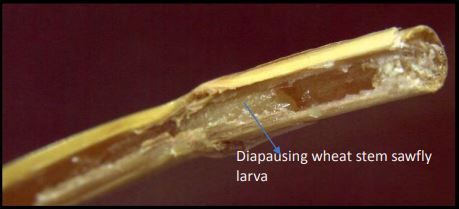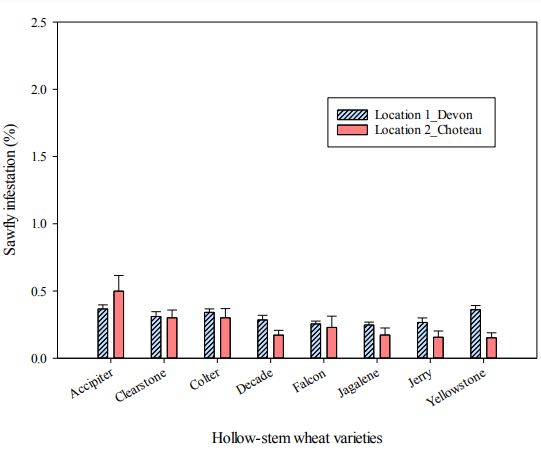Efficacy of entomopathogenic nematodes against wheat stem sawfly, Cephus cinctus (Hymenoptera: Cephidae)
Principle Investigator: Dr. Gadi. V.P. Reddy
Co-operators: Dr. Sindhu Krishnankutty, Dr. Brian Thompson, John Miller, Julie Prewitt and Debra A. Miller.
Western Triangle Agricultural Research Center, Montana State University, 9546 Old Shelby Road, P.O. Box 656, Conrad, MT 59425
Abstract
Despite considerable research efforts in the management of Wheat stem sawfly (Cephus cinctus), (WSS) this ‘million dollar pest’ continues to be a burden to wheat growers in Northern Great Plains. In the present study, we examined the effectiveness of different strains of entomopathogenic nematodes (EPNs) for controlling WSS larvae at their diapause stage. EPN strains mixed with water as well as Barricade® were applied on wheat stubble of eight different hollow-stem varieties. Results showed no significant difference in the number of dead sawfly larvae among the nematode treatments. However, we found there is significant difference in the number of dead sawflies among the wheat varieties.
Objective.
To evaluate the efficacy of different strains of entomopathogenic nematodes against diapausing larvae of WSS at two field locations in Montana.
To evaluate the level of infestation of WSS among different hollow-stem varieties.
Materials and Methods.
Field experiments were conducted in August 2014 at two locations in Montana, one at Devon (N48° 33' 14.94 W112° 23' 42.96") and the other in Choteau (N47° 56' 52.1916 W112° 2'
35.5956") (fig.1). Eight hollow-stem wheat varieties were planted in the field and the plots were arranged in a complete randomized block design (CRD) with three replicates. Each plot was 3.6 m x 1.2 m (48 Sq. Ft.) and consisted of four rows. Each row was equally divided into two (6 ft each) so that eight treatments (Table 1) could be applied in a single plot. Each treatment was replicated thrice within each variety. Entomopathogenic nematodes (EPNs) were sprayed over wheat stubbles containing diapausing WSS larvae. WSS larvae overwinter within the stem after plugging the stem with frass at it opening (Fig. 1). The plug protects the larva from excessive cold and dry conditions. The nematode concentrations were calculated based on recommendation rates for foliar application of pests by the manufacturer (Table 1). Nematodes were kept in a cooler at 10-15˚Celsius during transportation to the field.
Wheat varieties used. Accipiter, SY Clearstone 2, Colter, CDC Falcon, Decade, Yellowstone, Jagalene, and Jerry (all are hollow–stem wheat varieties)
EPN strains used. Three different strains, Steinernema carpocapsae, Heterorhabditis bacteriophora and S. feltiae were used. These strains were selected based on natural foraging strategies. S. carpocapsae has ‘ambush’ or ‘sit- and-wait’ foraging strategy. H. bacteriophora is a ‘cruiser’ meaning it actively seeks out its prey. S. feltiae has an ‘intermediate’ strategy between ‘ambush’ and ‘cruise’ strategies that helps them to infect both mobile and sedentary pests. The mix of foraging strategies provides a gradient to evaluate nematode habit in controlling sawfly.
Evaluation method. Infection of diapausing WSS larvae by nematodes was assessed by counting the dead larva in the stubble. Three wheat plants with multiple stubbles were randomly uprooted from each treatment area one week after spraying and were inspected later in the lab to check for the presence of dead larva.
Statistical analyses. The difference among treatments in wheat varieties and number of WSS larvae in the stubble were evaluated. All data were tested separately for normality using the Shapiro-Wilk test. As the data failed the normality test, ANOVA on ranks (Kruskal-Wallis test, overall significance level = 0.05) was used to determine statistical significance. All analyses were done using SigmaPlot v. 13.0 software (Systat Software Inc., San Jose, CA, USA).
Results.
There were no significant differences in the number of larvae found among treatments in both the locations (Location 1_Devon: P=0.103; Location 2_Choteau: F= P=0.844; Fig. 1). Slight significant difference in number of dead larvae was found among varieties (Location 1_Devon: P=0.014; Location 2_Choteau: F= P=0.010). Among wheat varieties, Accipiter and Yellowstone were found to be infested with more sawflies.
Discussion.
Results showed no significant difference among the treatments. The presence of a stem plug that does not retain water and the tendency of diapausing larvae to move towards the bottom of the stem when disturbed can be two main causal factors that affected survival and infectivity of nematodes in the wheat stubble. Future research efforts should be aimed at improving the survival capacity and penetration of nematodes in the stem lumen environment.
Acknowledgements
This work was supported by United States Department of Agriculture- Cooperative Regional Project W3185 Biological Control in Pest Management Systems of Plants and Montana Wheat and Barley Committee. We greatly appreciated local growers for allowing us to use their wheat fields to conduct the experiment in Devon, Montana.
Figure 1. Wheat stubble (cut open) with diapausing stem sawfly larvae inside
Table 1: Material, and rate of application in each treatment.
|
Treatment |
Material |
Trade name |
Rate |
Source |
|
T1 |
Water spray (control) |
- |
- |
- |
|
T2 |
Barricade (control) |
Barricade® |
30 ml/1L |
Barricade International Inc., FL |
|
T3 |
Steinernema carpocapsae + Water |
Millenium® |
250 million/10000 sq ft. |
BASF, Ames, Iowa |
|
T4 |
Heterorhabditis bacteriophora + Water |
Nemasys G® |
50 million/ 1000 sq. ft |
BASF, Iowa |
|
T5 |
Steinernema feltiae + Water |
Nemasys® |
50 million/4300 sq. Ft |
BASF, Iowa |
|
T6 |
S. carpocapsae + Barricade® |
Millenium® |
Same as above |
BASF, Ames, Iowa |
|
T7 |
H. bacteriophora + Barricade® |
Nemasys G® |
Same as above |
BASF, Ames, Iowa |
|
T8 |
S. feltiae + Barricade® |
Nemasys® |
Same as above |
BASF, Ames, Iowa |
Figure 2. Number of dead sawfly larvae in treatments with different strains of entomopathogenic nematodes (mean ± SE). T1: Water spray; T2: Barricade; T3: Steinernema carpocapsae + Water; T4: Heterorhabditis bacteriophora + Water; T5: S. feltiae + Water; T6: S. carpocapsae + Barricade; T7: Heterorhabditis bacteriophora + Barricade; T8: S. feltiae + Barricade
Figure 3. Number of dead sawfly larvae among different hollow stem wheat varieties (Mean ± SE).



